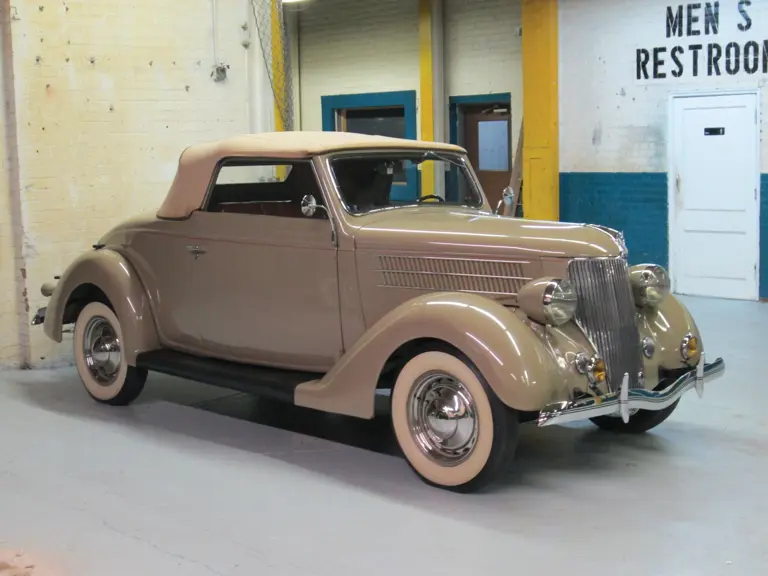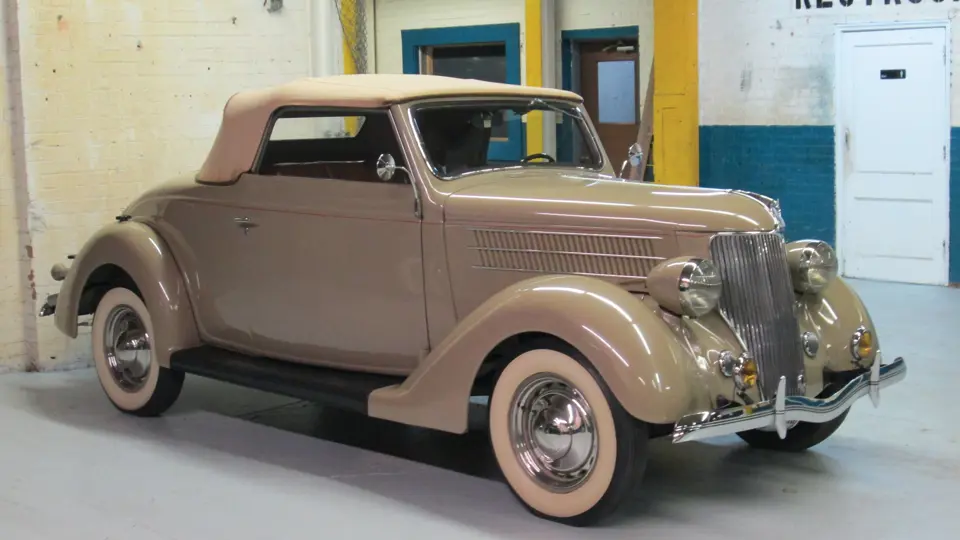Henry Ford once again made automotive history in 1932 when he introduced a new, affordably priced automobile that was powered by a V-8 engine. The new model, called the Model 18, was a completely new car in comparison to his previous automobile – the Model A which Ford built for four years. The new V-8 powered Ford had a completely redesigned chassis that was lower to the ground and stronger in design. The gas tank, which was mounted on the cowl, was now moved to the rear of the frame and the bodies were more streamlined in appearance.
Ford’s V-8 engine was a milestone in engineering design. Ford started designing the engine in late 1930. Unlike other V-8 engines of the time that were built using two separate four-cylinder blocks mounted on a separate crankcase, Ford incorporated the crankcase and the cylinders into one simple casting. This made it not only less costly to produced, but also more durable. The engine was designed with an L-head valve arrangement and had removable cylinder heads with low and flat looking exterior appearances, which made the engine known amongst enthusiasts as Ford’s famous “Flathead” V-8.
Ford would continue to develop and improve the V-8 engine. The first versions built in 1932 were 65 horsepower. By 1933, the horsepower was increased to 75 and by 1935 to 85. In 1939, the horsepower was increased again to 90 and by 1946, when the final re-design was issued; the horsepower had increased to 100. Ford continued using this engine until 1954 when it was replaced by an overhead valve engine.
Ford not only changed the engine, but the exterior design as well. In 1933, the vertical grille was replaced by a slanted, chrome grille and the fenders now had front and rear aprons to cover the chassis components. The overall body height was reduced and the windshields were raked to the rear. 1935 saw another major re-design with bodies that were more rounded, smaller wheels, and a more integral grille and front fender assembly. During the period from 1934 to 1942, Ford redesigned the vehicles every year, making each year distinctively different from the others.
This 1936 Ford model line was introduced in October of 1935 and during this year, 748,554 vehicles were built and sold. The 1936 Fords were offered in fifteen different body styles and offered as standard and deluxe models. The 1936 Fords were basically redesigned 1935 models with a more rounded front end and hood.
The Cabriolet body style was only offered in the deluxe line and approximately 17,000 of this body style were produced this year, compared to nearly 350,000 sedans.
This example is an excellent and proper older restoration of what appears to have been a very solid and intact vehicle. This car is powered by its proper 1936, 85 horsepower V-8 engine. Many of the early 1930s Fords have had later V-8 engines installed and it is unusual to find one with its proper engine. The engine has been restored and detailed and is complete with its correct carburetor, fuel pump, distributor, etc. While showing signs of use, it remains in clean condition. The chassis is also complete and correct and shows no signs of major damage or excessive wear. The correct 16-inch steel wheels appear in good condition and are fitted with period reproduction accessory whitewall tires.
The body appears very solid. The door fit is fair to good and the alignment of the hood is straight. The fenders look to be undamaged and fit the body well. The tan paint shows light signs of use, but remains in very good to excellent condition with good gloss and a consistent surface finish. It is properly accented with a red stripe. The interior is replaced with a proper LeBaron Bonney interior kit. The interior shows only minimal signs of use and remains in excellent condition including the door panels, side panels, floor mat, etc. The dashboard is complete with its proper gauges and controls and has been properly restored in a period-correct woodgrained finish. The tan convertible top shows minor signs of staining and use, but is still quite usable and presentable. The rumbleseat interior is also in excellent condition. The chrome and stainless steel trim pieces are very clean and presentable.
This car is fitted with typical period and factory accessories including a metal spare tire cover, spider hubcaps, bumper guards, foglights, turn signals, a rearview mirror, dual exterior mirrors, plus a clock and whitewall tires. Overall, this is an authentic, but older restoration of a very desirable early Ford V-8 Cabriolet.



 | Auburn, Indiana
| Auburn, Indiana


